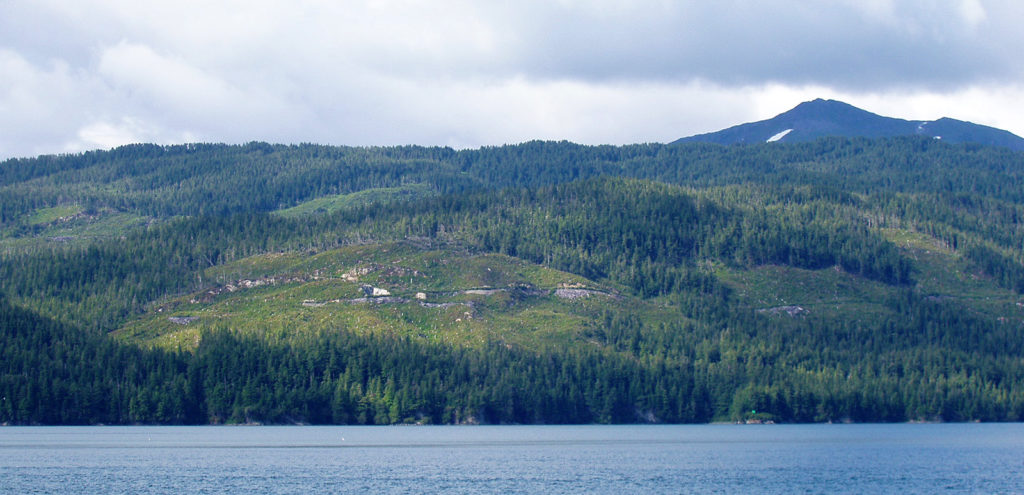
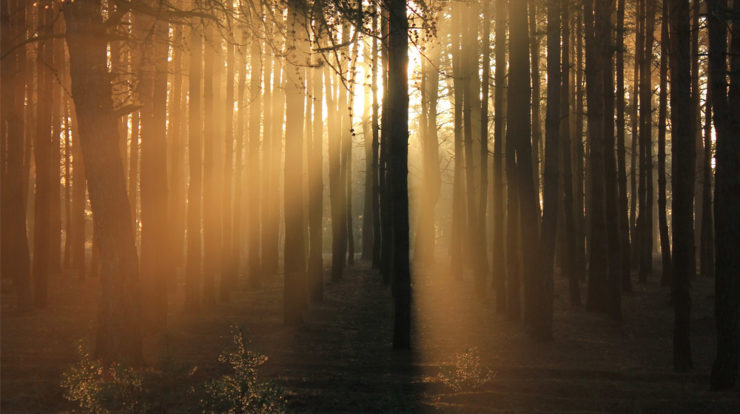
Features
Complex Nature: Implications for Forests with the Rise of Mass Timber Construction
Georgina Davis
Share
Deep Roots
Although Laugier’s proverbial primitive hut was a metaphorical device, its references to man’s connection to nature depict shelter provided by trees. Besides a long-standing connection to their physical protection (e.g., the offer of prospect and refuge as described by the savanna hypothesis1) and symbolic reverence (e.g., the ancient Roman and pagan traditions of bringing a bit of evergreen into the home around the winter solstice), our connection to forests affects us on an emotional level. As a building material it also brings enjoyment through its distinct scent, the feel of its grain, and the warmth of its glow by sunlight or flame.
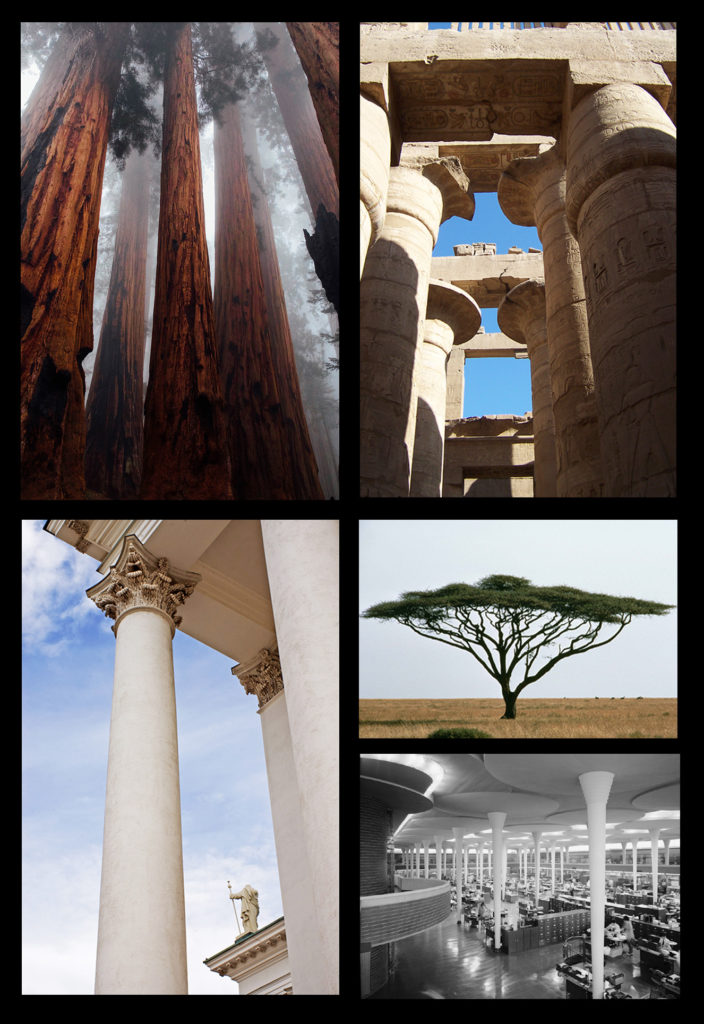
Clockwise from top: Redwoods, William Headings/Flickr; Karnak-Dean Sas/Flickr; Corinthian Columns, Robin/Flickr; Westminster Cathedral, B0g4rt/Flickr; Johnson Wax Building/WikiCommons; Umbrella Thorn Acacia, Stolz, Gary M/U.S. Fish and Wildlife Service.
Today’s advanced engineering techniques have given us not just dimensional lumber and plywood but engineered wood: combining conventional pieces of wood to create solid, unobtainable spans and depths. With mass timber construction (MTC), designers can specify wood products for taller buildings, allowing the wider use of a biophilic material in mid and high-rise residential. This is also exciting because of MTC’s green credentials (compared to concrete and steel), and it is motivating different building sectors to increase the use of this sustainable product obtained through sustainable forestry.
If what you just read has made a small alarm go off in the back of your mind, you are not alone. Between the increasingly vague “sustainable” label and the contradictory sounding “sustainable forestry,” there are plenty of questions. The answers are not always straightforward, with several variables dependent on how they are defined and weighted. Exploring these challenges is how we can escape past mistakes and still find a path forward without being lulled into complacency by an opaque process and decorative green stamp of approval.
She's looking into my eyes, she's holding my hand She says, "You can't repeat the past, " I say, "You can't? What do you mean, you can't, of course you can." --Bob Dylan, “Love & Theft”
1 See Orians & Heerwagen, 1992.
Wonder Wall
Most European and U.S. forests of giant trees were harvested long ago. Heavy timber in its true form no longer exists at a large, commercial scale, although through the wood reclamation process one can still find specimens of all sizes. To most people, modern wood construction is largely “stick frame” (i.e., dimensional lumber and plywood). Its performance is not as strong or uniform as steel and concrete, and after a number of disasters, it has been restricted to heights accessible by fire truck ladders. However, recent inventions like Glulam and cross-laminated timber (CLT) (two types of MTC) make it possible to create and specify slabs of wood 20 inches thick and beams spanning up to 60 feet —all by fusing smaller, easily obtainable pieces. Because of its similar fire resistance to heavy timber (some would call it better than steel) MTC products can be used in projects where stick frame is prohibited.2
Manufacturing MTC is efficient in both cost and material usage, even before you factor in its lighter weight, which allows for faster construction times and lighter concrete foundations. Its precision manufacture means an offsite finish and very little waste.3 And if you want a real cause for celebration, consider that unlike fossil fuels, trees are renewable (on a human timescale) and unlike steel and concrete, their transformation into mass timber products contributes less carbon into the atmosphere. In fact, trees sequester carbon —regardless of age (Ford and Keeton 2017; Stephenson et al. 2014) and even after they are harvested and made into timber products.
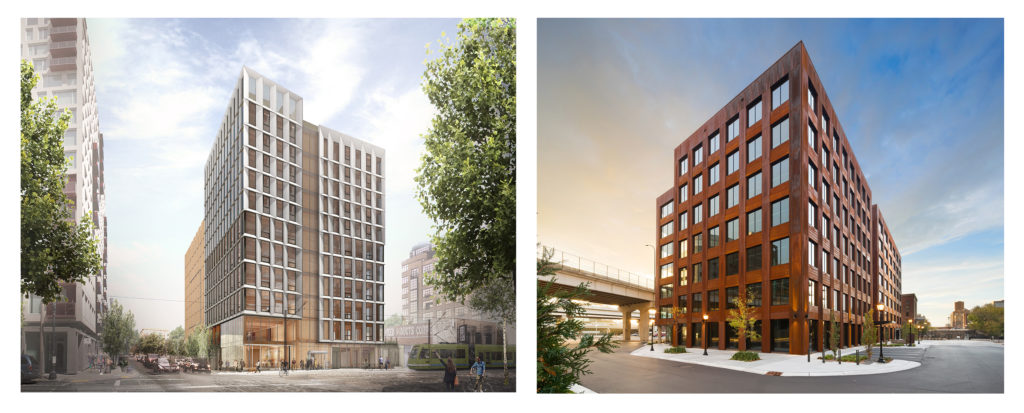
(left) Framework, Portland, OR, Lever Architects (USDA/Flickr); (right) T3, Minneapolis, MN, Michael Green Architects (USDA/Flickr)
Before we commence with festivities, it is important to step back and look at the bigger picture. The increased use of timber and the rise of MTC is not the answer to every problem; as with many choices it has its perks and drawbacks, and the way forward is not always black and white. It is worth understanding how forests, silviculture, and MTC fit into the carbon cycle. We should also examine the common assumption put forth in nearly every description of mass timber: that trees harvested for MTC are procured with sustainable methods from sustainably managed forests. Sounds good, but what does that mean? Understanding the grey areas is how we make informed choices, because this should not be an either/or discussion about halting all timber harvest or creating a kind of derby. It should be about making the best choices for the world we have shaped, keeping in mind the world we want for our future.
2 Currently most MTC projects in the U.S. must still obtain exemptions after extensive testing.
3 Waste created during tree harvest can be converted to biomass.
Can’t See the Forest Through the Trees
Reservations about increasing our demand for wood products arise when viewing timber harvests solely by the numbers, as this paints an incomplete picture. Just as the fishing industry has learned that focusing on one species to the detriment of others is unsustainable, and that protecting oceans as whole is the only way to ensure future livelihoods (and food stocks), foresters are realizing that the way forward should include neither indiscriminate clearcutting nor the artificial monoculture of vast tree plantations.
Today the idea of the forest network (the “Wood Wide Web”) is gaining prominence over the dominant view of the last half century, that “… plants [are] individuals … to be studied with neat statistical precision, as if they were atoms” (Benyus in Hawken 2017). If the goal is not just to be sustainable but regenerative, we must define our priorities; if the preservation of forests as “wild” ecosystems presents a moral responsibility, then it is necessary to approach the commodification of timber more holistically, and not just as an exercise in efficiency or a mathematical challenge in balancing the world’s net carbon output. If we choose not to consider these important, then at least we do not proceed uninformed.
What qualifies as “sustainable forestry” on paper depends on point of view, but fundamentally a tree stand is not a forest. Trees are “renewable” but forests are complex ecosystems that evolve over decades and centuries; they are not rows of crops grown to maximize efficiency and yield. The terms “forestry” and “managed forest” can also be misleading, since foresters’ primary goal is logging (i.e., tree production and harvest), not preserving or promoting forest ecology; in nature a forest does just fine without human intervention. All managed lands, whether they be for economic or recreational benefits (e.g., for hunting, fire prevention, agriculture/silviculture), are the product of human intervention. Acknowledging this distinction is essential to understanding why calling these areas “forests” is disingenuous.
Sidebar: What is an old-growth forest? There is no single definition for this commonly used descriptor, allowing it to be used for a variety of purposes (e.g., forestry, science, conservation). Since ecosystems are complex, terms and definitions for them need to exhibit flexibility (Spies, in PNRS 2003). Although it might sound logical, requiring the definition to exclude any forest altered by humans is generally considered too restrictive and unrealistic. Limits on age, stand development, or economic viability are all important, but none hold can uphold a comprehensive definition (Henry 2015). Moreover, any list of characteristics of an old-growth forest may be affected by natural disasters (e.g., fires) or simply become more pronounced over time. Complexity, biodiversity, and heterogeneity in age and species of trees are crucial characteristics of old growth and are absent in tree plantations. The story of any forest’s path towards “old-growth” is so complex, it only exists in nature. Man may try to mimic the process, and at times he may come close, but it will always be a shadow of the complete picture. For the purposes of this article, a “virgin forest” will refer to one that has never been logged (no evidence of clear cutting or presence of logging roads), and an “old-growth forest” will mean one that has returned to a high level of complexity and diversity, is usually beyond economic viability, and may be protected but not actively managed.”
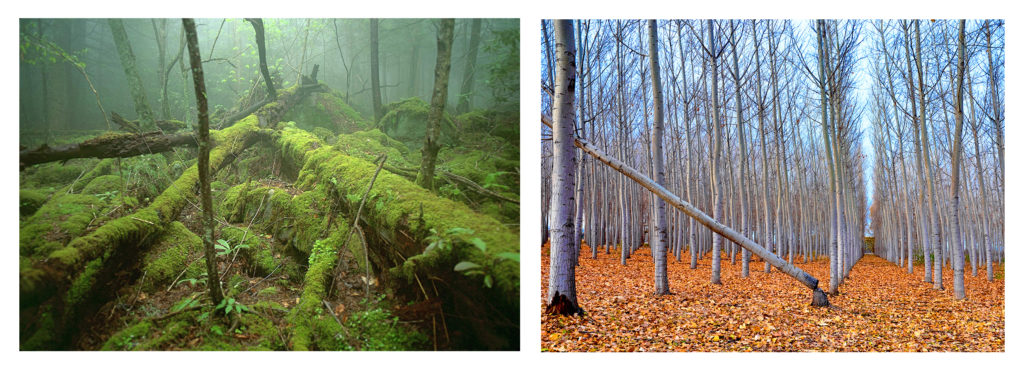
(left) The complexity of a virgin forest understory (Great Smoky Mountains, North Carolina), Richard Bonnett/Flickr; compared with tree farms near Weiser, Idaho (right). Nature (and beavers) hate straight lines, Charles Knowles/Flickr.
Many in the forestry industry conclude that man has already altered wild lands so much that he must continue to manage future growth in the same way that domesticated animals rely on humans for survival. “The present fragmentation, reduction in forest area, and imbalance of [forest] structures may mean that it is prudent for active management to provide the diversity of structures rather than anticipate that natural processes will return the diversity” (Oliver 1992).4 We may not like our current predicament, but for the moment we may have to accept it as the fly we have swallowed. Simply saying no to any further logging or silviculture is not an option. Saying yes to finding the best way to allow logging with an acceptable level of disturbance, and hopefully no further encroachment on virgin areas, is the best path available to us. Fortunately, there is already research into how best to do this.
Land managed for silviculture should be kept healthy by promoting methods that keep its susceptibility to fire and pests low, and homogenous tree stands can weather neither of these disasters well. (MTC is currently taking advantage of a surplus timber product because of a largely self-inflicted plague of pine beetle and spruce budworm in the U.S. and Canada). Forests should also be preserved since the very act of converting (i.e., clear cutting) old-growth forests to managed forests results in an immediate decline in carbon stocks, one that does not recover quickly enough to maintain an equilibrium (Sathre and O’Connor 2010).
The ability of wood products to sequester carbon even after harvest is a remarkable feature of a building material. The problem is not the presence of carbon, but its concentration in the wrong place (the atmosphere).5 Forests and oceans do their part to keep the atmosphere balanced, but when pushed to their limits, they cease functioning as carbon sinks and become sources. Additional anthropogenic fossil fuel emissions only add to the problem in balancing the carbon cycle (Fig 1).
“To help reverse global warming, we will need to step into the flow of the carbon cycle in new ways, stopping our excessive exhale of carbon dioxide and encouraging the winded ecosystems of the planet to take a good long inhale as they heal.”6
Recently it has been suggested that the world’s tropical forests have been so badly damaged that they no longer sequester carbon (Baccini 2017).7 Temperate forests remain a powerhouse in carbon sequestration despite a long history of targeted exploitation.8 Forests —trees, roots, branches, and the forest floor— collectively store tons of carbon (worldwide they offset about 30% of anthropogenic emissions, and nearly 16% of that from the U.S.9).
Using timber in place of steel and concrete means lower fossil fuel emissions, as well as the preservation of the carbon held in the structure itself. A warning that favoring logging priorities may prevent concurrent promotion of biodiversity and carbon sequestration (Oliver, 2014) is addressed by Ford and Keeton (2017), who present multiple studies that suggest “less intensive management focused on promoting structural complexity may provide an alternative, contributing to climate mitigation through enhanced carbon storage while providing late-successional habitats.” Implementing these “structural complexity enhancement (SCE) treatments” to promote healthy and diverse stands may be one way balance tree harvesting, healthy habitats, and economic viability (Ford & Keeton 2017).
This approach suggests that mimicking old-growth characteristics is a viable alternative to traditional logging, and it contributes to carbon sequestration. Here we see an example of an approach that does not treat forests as a collection of trees but includes its value as habitat alongside economic potential and carbon sequestration. This distinction is important to make, and it opens the discussion on the value of managed lands and the nuances of “putting back” what you take out.
Academic studies may show promise but delivering results in the private sector is often another matter. Organizations like the Rainforest Alliance and their Forest Stewardship Council put it like this: “The hallmark of sustainable forestry, from a purely ecological perspective, is the extent to which silvicultural practices mimic nature’s patterns of disturbance and regeneration. Responsible forest managers balance the needs of the environment, wildlife, and forest communities —supporting decent livelihoods while conserving our forests for generations to come” (Rainforest Alliance). This is a commendable goal and a tall order. Even if the reach of the FSC is small (10-12% of the world’s forests are certified), we need organizations to oversee domestic timber harvest practices as well as imports.
How successfully this mission statement plays out is not always clear because the source and supply chain are so far removed from most consumers, and the FSC has had its share of criticism over the years (Reed 2013). It is essential to press upon authorities the importance of verification lest we find ourselves with another meaningless “green” label, or an array of confusing marketing ploys.
4 In the words of Wally Hickel, “You can’t just let nature run wild.”
5 Carbon in the atmosphere helps insulate the planet, but too much sets us on a Venusian path.
6 Janine Benyus, in Hawken (ed.) Drawdown, p. 215.
7 Calculations on this scale depend on variables that can be difficult to quantify.
8 There are estimates that 99% of the world’s temperate forests have been disrupted by man (Hawken, 2017).
9 Pan et al., 2011, and EPA, 2012, in Ford & Keeton, 2017
Future of Forests and MTC
If making clear choices that stand up to scrutiny is important to consumers, it is up to them to decide what is acceptable as responsibly sourced timber, and then to keep demanding high quality oversight, just as they do with other products, such as coffee, cotton, and seafood. It is up to the design and construction industry to work with foresters and ecologists to ensure that the future of MTC promotes silvicultural standards that do not masquerade as forest substitutes, but provide timber in ways that maximize biodiversity, even to the detriment of profits. Ideally this approach also augments carbon sequestration.
Virgin forests should remain off-limits, and the reestablishment and protection of old-growth forests promoted. When possible, these areas should be linked with national parks, preserves, and wildlife crossings over major infrastructure that create unbroken wildlife corridors.9 This method will probably not maximize monetary profits, which is why it is important to define our priorities.
Happily, the general consensus is that by nearly every measure, MTC is an excellent choice for construction, although it will not entirely replace steel and concrete (rather, these material choices make excellent hybrid structures). It should be included in the building code and its increased use should be encouraged by supporting research, experimentation, and certification for it as a safe and desirable building system. If this is the moment when we decide to increase the use of wood in our cities through MTC, then there is no better moment to ensure we do not allow this rush to cause more deforestation in the name of “sustainability.”
9 This action does not fall to voluntary organizations, but to governments and exceptional cases (such as the Patagonia National Park, which was purchased by private individuals then donated to the government, provided that they added even more land to it).
References
Baccini, A., et al. (2017). Tropical forests are a net carbon source based on aboveground measurements of gain and loss. Science 358, 230–234.
Ford, S. and Keeton, W. (2017). Enhanced carbon storage through management for old-growth characteristics in northern hardwood-conifer forests. Ecosphere, 8(4).
Hawken, P. (2017). Drawdown: The most comprehensive plan ever proposed to reverse global warming. New York, New York: Penguin Books.
Henry, M. (2015). What is old-growth forest? Posted on February 24, 2015. Ancient Forest Exploration & Research (AFER). <http://www.ancientforest.org/what-is-old-growth-forest/>
Orians, G.H. & J.H. Heerwagen (1992). Evolved Responses to Landscapes. In J.H. Barkow, L. Cosmides, & J. Tooby (Eds.), The Adapted Mind: Evolutionary Psychology and the Generation of Culture (555-579). New York, NY: Oxford University Press.
Oliver, C. D. (1992). A landscape approach: Achieving and maintaining biodiversity and economic productivity. Journal of Forestry, 90, 20–25.
Oliver, C.D., Nassar, N.T., Lippke B.R., and McCarter, J.B. (2014) Carbon, Fossil Fuel, and Biodiversity Mitigation with Wood and Forests, Journal of Sustainable Forestry, 33:3, 248-275.
Reed, S. (2013). “How Reliance on Trees Can Help Forests.” New York Times, June 19, 2013.
Sathre, R. and J. O’Connor. (2010). A Synthesis of Research on Wood Products and Greenhouse Gas Impacts, 2nd Edition. Vancouver, B.C. FPInnovations. 117 p. (Technical report TR-19R).
Spies, T. A. (1996). The Diversity and Maintenance of Gold-Growth Forests, in Sazro, R.C., and Johnston, D.W., (eds.) Biodiversity in Managed Landscapes: Theory and Practice. Oxford University Press: New York, p. 778.
Stephenson, N. L., et al. (2014). Rate of tree carbon accumulation increases continuously with tree size. Nature, 507(7490), 90-93.
Feature image: Sang Trinh/Flickr
Header Image: Valeriy Andrushko/Unsplash
Georgina Davis
is a research analyst at Terrapin and has a background in architecture and field research. She completed her master’s and doctoral degrees at Texas A&M University and her bachelor's at Washington University in St. Louis. Her interests include energy efficiency and occupant comfort in extreme environments and bio-inspired innovation.
Topics
- Environmental Values
- Speaking
- LEED
- Terrapin Team
- Phoebe
- Community Development
- Greenbuild
- Technology
- Biophilic Design Interactive
- Catie Ryan
- Spanish
- Hebrew
- French
- Portuguese
- Publications
- Occupant Comfort
- Materials Science
- Conference
- Psychoacoustics
- Education
- Workshop
- Mass Timber
- Transit
- Carbon Strategy
- connection with natural materials
- interior design
- inspirational hero
- biophilia
- economics of biophilia
- Sustainability
- wood
- case studies
- Systems Integration
- Biophilic Design
- Commercial
- Net Zero
- Resorts & Hospitality
- Energy Utilization
- Water Management
- Corporations and Institutions
- Institutional
- Ecosystem Science
- Green Guidelines
- Profitability
- Climate Resiliency
- Health & Wellbeing
- Indoor Environmental Quality
- Building Performance
- Bioinspired Innovation
- Biodiversity
- Residential
- Master Planning
- Architects and Designers
- Developers and Building Owners
- Governments and NGOs
- Urban Design
- Product Development
- Original Research
- Manufacturing
- Industrial Ecology
- Resource Management
- Sustainability Plans
- Health Care
- Carbon Neutrality

